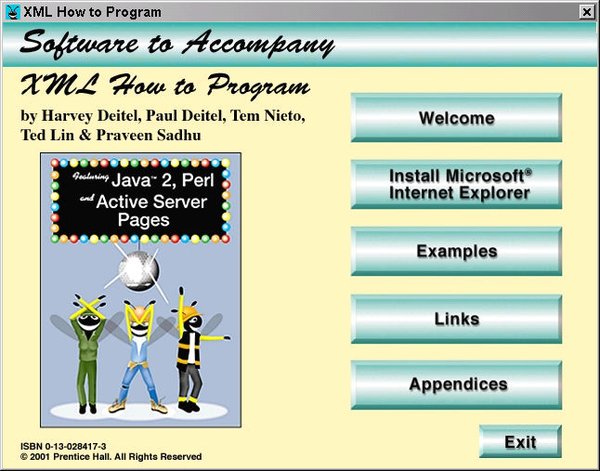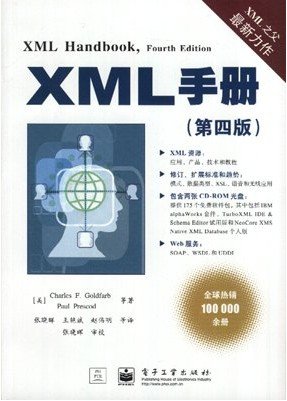Beginning XML Databases CHM Beginning Xml Databases chm
文章类别:
- 1 12 月, 2022
- 0 条评论
- Mastering Unix Shell Scripting 第二版
- 程序员成长之路:ASP·NET程序员成长攻略 扫描版 陈哲 陈哲 扫描版 pdf
- Silverlight 4中使用Visual C Sharp 2010视频教程第二辑 (AppDev Silverlight 4 Using Visual C AppDev Silverlight 4 Using Visual C Sharp 2010 DVD Volume 2-iNKiSO iso
- The Pragmatic Bookshelf开发丛书-使用Rails开发Facebook平台应用 (Developing Facebook Platform Michael J· Mangino Developing Facebook Platform Applications with Rails Michael J Mangino 文字版 pdf
- Head First Ajax 扫描版 赖尔 扫版描 pdf
- 微机接口技术 文字版 王成端 王成端 文字版 pdf

 (0 次顶, 0 人已投票)
(0 次顶, 0 人已投票)你必须注册后才能投票!
快捷索引
会员福利
版本: CHM
发行时间: 2006年11月13日
简介:

书名:Beginning XML Databases (Wrox Beginning Guides) (Paperback)
作者:by Gavin Powell (Author)
页数:470 pages
出版:Wrox (November 13, 2006)
语言:English
ISBN-10: 0471791202
ISBN-13: 978-0471791201
本书详细地介绍了XML数据库的设计技术。内容包括: XML和数据库理论的介绍、数据库的设计技术、XML数据库的理论基础、数据的存储方法、服务器的设计、现有的商业数据库集成XML文档或XML数据库产品的介绍、XML数据服务器的用户界面、查询XML文档的几种技术、XML数据库的索引技术、具体的实施案例。本书附带光盘包括Apache Tomcat、Xerces XML,以及可以用来构建XML数据库的实例。
http://www.amazon.com/Beginning-XML-Databa…71791202

Book Description
Supported by all major database systems, XML provides an easy, standardized method of transferring data between databases and to and from the Web, independent of the software in use
Offers database programmers and data-driven Web developers detailed guidance on how to understand and work with XML as data
Numerous hands-on, step-by-step examples help readers learn to simplify database work using XML
Shows how to use XML to exchange data between multiple databases either internally or with external customers and partners
Covers XML in popular databases including Oracle Database, SQL Server, and brief coverage of DB2 Database
Covers basic syntax for XML, the XML DOM, and XSL – with an emphasis on database use, and native XML databases
Additional topics covered include Native XML databases, XPath, XQuery, XLink, XPointer, DTDs, XML Schemas, among others
From the Back Cover
The union of XML and relational databases creates a powerful tool with the ability to transfer information between two completely unrelated databases. With this book, veteran author Gavin Powell shows you how this confluence of two technologies can simplify your database work and provide a more standardized way to exchange data between multiple databases and web sites.
You'll get an in-depth look at specific XML datatypes that are considered the most critical alliances between XML and a relational database. Plus, an introduction to the basics of SQL and numerous XML standards prove to be essential so that you can grasp database structure and comprehend how XML is used with the Oracle® and SQL Server relational databases. Throughout the book, valuable exercises and a surfeit of step-by-step examples will help you get an overall understanding of the topics at hand.
What you will learn from this book
The platform independence capability that comes from using XML— including independence from database vendors
The basics of XML, XSL, the XML DOM, and SQL
XML datatypes and features in Oracle Database and SQL Server
How to move data anywhere using XML (B2B)
Ways to read XML documents using XQuery and navigate documents using XPath®
XML, the object data model, native XML databases, and industry applications of XML
Who this book is for
This book is for anyone—from novice to expert—who is interested in learning the details of XML and database technology as applied to both XML and relational database technology, working together.
Wrox Beginning guides are crafted to make learning programming languages and technologies easier than you think, providing a structured, tutorial format that will guide you through all the techniques involved.
Introduction.
Chapter 1: What Is XML?
Comparing HTML and XML.
What Is XML Capable Of?
What Is XSL?
Creating and Displaying a Simple XML Document.
Embedding XML in HTML Pages (Data Islands).
Introducing the XML Document Object Model.
XML Browsers and Different Internet Browsers.
The Document Type Definition.
XML Syntax.
Elements.
Attributes.
Reserved Characters in XML.
Ignoring the XML Parser with CDATA.
What Are XML Namespaces?
XML in Many Languages.
Summary.
Exercises.
Chapter 2: The XML Document Object Model.
Basic XML DOM Structure.
The Primary XML DOM Classes.
The Node Class.
The Document Class.
The Element Class.
The Attr Class.
The Text Class.
More Obscure XML DOM Classes.
The parseError Class.
HttPRequest Class.
Other Classes.
Generating XML Using ASP.
Summary.
Exercises.
Chapter 3: Extending the Power of XML with XSL.
What Is XSL?
The Roots of XSL.
Basic XSL Elements Syntax.
Processing Instruction Elements.
Transformation Elements.
Node Creation Elements.
Data Retrieval Elements.
Control Structure Elements.
Advanced XSL Syntax.
Function Versus Method.
XSL Function Syntax.
XSL Method Syntax.
XSL Pattern Matching Syntax.
Combining the XML DOM and XSL.
Summary.
Exercises.
Chapter 4: Relational Database Tables and XML.
Using SQL for Database Access.
Queries.
Changing Data in a Database.
Generating XML Pages Using Basic SQL.
Summary.
Exercises.
Chapter 5: Oracle Database and XML.
The Oracle XMLType Data Type.
Oracle XMLType Data Type Methods.
Implementing XML in an Oracle Database.
Creating XML Documents from an Oracle Database.
XML and the Database.
New XML Documents.
Retrieving from XML Documents.
Using XMLType Methods to Read XML Documents.
Changing and Removing XML Document Content.
Summary.
Exercises.
Chapter 6: SQL Server and XML.
The SQL Server XML Data Type.
SQL Server XML Data Type Methods.
Generating XML: The FOR XML Clause.
FOR XML RAW Mode.
FOR XML AUTO Mode.
FOR XML EXPLICIT Mode.
FOR XML PATH Mode.
Generating Tuples from XML: OPENXML.
Working with XML Data Types.
Adding XML Documents to SQL Server.
Retrieving and Modifying XML Data Types.
Defining XML Content with XSD Schemas.
Strongly Typing XML Documents with XSD.
Mapping an XSD Schema to a Table.
Annotating the XSD Script to Enforce Relationships.
Storing XSD as a Schema Collection.
Creating Indexes on XML Data Types.
Summary.
Exercises.
Chapter 7: XML in Heterogeneous Environments.
Basic XML Document Transfer.
Sharing XML with Web Services.
The HttP Protocol.
Transformation Processing.
Web Services Protocol.
Applying Semantics to XML Transfers.
Simple Object Access Protocol.
External Data and XML.
B2B Data Transfer.
Summary.
Exercises.
Chapter 8: Understanding XML Documents as Objects.
Why Explain the Object Model Here?
XML Data as a Relational Structure.
The Basics of the Object Data Model.
Creating an Object Model from a Relational Model.
XML Data as an Object Structure.
Summary.
Exercises.
Chapter 9: What Is a Native XML Database?
An XML Document Is a Database.
Defining a Native XML Database.
Creating a Native XML Database.
Schema-Less Native XML Database Collections.
What Is Indexing?
What About Using XSL and the XML DOM?
Classify Native XML Databases by Content.
Document-Centric XML.
Data-Centric XML.
Using a Native XML Database.
Summary.
Exercises.
Chapter 10: Navigating XML Documents Using XPath.
What Is XPath?
Absolute and Relative Paths.
XPath Nodes.
XPath Node Relationships.
XPath Expression Syntax.
Simple Expressions to Find Nodes.
Find Specific Values Using Predicates.
Use Wildcards to Find Unknown Nodes.
Expressions on Multiple Paths.
XPath Axes.
XPath Functions.
Accessor Functions.
Errors and Tracing.
Constructor Functions.
Numeric Functions.
String Functions.
URI Functions.
Boolean Functions.
Functions on Durations, Dates, and Times.
QName Functions.
Node Functions.
Sequence Functions.
Context Functions.
Summary.
Exercises.
Chapter 11: Reading XML Documents Using XQuery.
What Is XQuery?
Shared Components.
The Basics of XQuery.
Executing XQuery Queries.
Embedding XQuery Code into HTML.
XQuery Terminology.
XQuery Syntax.
Functions in XQuery.
XQuery FLWOR.
FLWOR: The Basic for Loop and Return Clause.
FLWOR: Adding a where Clause.
FLWOR: Adding an Order By Clause.
FLWOR: Declaring Variables with the Let Clause.
FLWOR: Embedded for Loops and Communication.
XQuery in Oracle XML DB.
What Is XQueryX?
Summary.
Exercises.
Chapter 12: Some Advanced XML Standards.
XLink and XPointer.
What Is XLink?
Simple XLinks.
Extended XLinks.
What Is XPointer?
XForms and HTML Form Generation.
The XForms Model.
XForms Namespaces.
Other XForms Input Types.
Data Types in XForms.
Restricting Values with XForms Properties.
XForms Object Actions.
Built-in and User-Defined Functions.
Binding Data Using XPath.
Embedding XML Documents with XInclude.
Formatting XML Output Using XML-FO.
Summary.
Exercises.
Chapter 13: Data Modeling and XML.
The Document Type Definition.
DTD Elements.
DTD Attributes.
DTD Entities.
The XML Schema Definition.
Global and Local Types.
Basic XSD Structures.
Substitution.
Summary.
Exercises.
Chapter 14: Applying XML Databases in Industry.
What Can XML Do?
Managing Complex Data with XML.
Does Database Size Matter?
Are Schema Changes Easier with XML?
Native XML Databases.
Specific XML Vocabularies.
XML Vocabularies.
Commercial Implementation of XML.
When to Use a Native XML Database.
Summary.
Glossary.
Appendix A: Exercise Answers.
Appendix B: The Sample Database.
Appendix C: Syntax Conventions.
Appendix D: XML Technology.
Appendix E: XML Relational Database Technology.
Index.
[通过安全测试]杀毒软件:kav 6.0
病毒库:2007-9-14
共享时间:不定时,一般在白天(ADSL宽带上网1M的一般上传都在30-40KB左右,
希望大家能帮忙分流.上传速度比较慢,请大家不要着急。
共享服务器:DonkeyseverNo.1
[通过安装测试]WindowsXP SP2
该下载内容仅限于个人测试学习之用,不得用于商业用途,并且请在下载后24小时内删除。版权归原作者所有,如果你喜欢,请购买正版。
书我要,下载先! http://www.books51.com/ 祝您开卷有益!
同类文章
文章类别:
本文链接: http://www.books51.com/291629.html
【点击下方链接,复制 & 分享文章网址】
Beginning XML Databases CHM Beginning Xml Databases chm → http://www.books51.com/291629.html |
上一篇: ASP.NET AJAX程序设计 第II卷 JPG 内含源代码 ASP NET AJAX程序设计 第II卷 客户端Microsoft AJAX Library与异步通信层 rar

 (0 次顶, 0 人已投票)
(0 次顶, 0 人已投票)你必须注册后才能投票!





最新评论